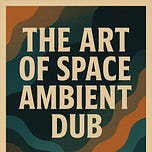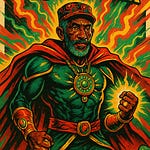(You can also download the show from my Podbean site: Download Here)
Ambient dub is the dreamlike extension of traditional dub—a sound world where slow-motion basslines, swirling echoes, and textured layers stretch out like scenes from a film you've never seen but somehow remember. It’s not dub for the dancefloor. It’s dub for drifting. For breathing. For letting go.
This form of dub doesn't chase the beat—it expands time. Born from the experimental instincts of pioneers such as King Tubby, Augustus Pablo, and Lee “Scratch” Perry, ambient dub evolved as producers began to lean into atmosphere, silence, and space. These weren’t just remixes—they were sonic landscapes, filled with emotion, tension, warmth, and mystery.
The Birthplace: Dub as Sound Design
In the 1970s, Jamaican engineers like King Tubby and Scientist turned reggae into something otherworldly. Using tape delays, spring reverbs, and hand-controlled faders, they stripped songs down to the essence, then rebuilt them with echo, silence, and sub-bass.
These mixes weren’t just musical—they were cinematic.
Dropouts. Panning. Ghostly reverb trails. It was like editing a film in sound.
That approach became the foundation of what we now call ambient or cinematic dub.
From Kingston to Cosmos: The Evolution of Ambient Dub
As dub spread beyond Jamaica in the 1980s and '90s, it collided with new cultures, genres, and technologies. The result was a global wave of ambient dub—abstract, soulful, and experimental:
UK & Europe: Labels like On-U Sound (Adrian Sherwood) and ROIR, as well as artists such as Dub Syndicate and African Head Charge, blended dub with post-punk, tribal rhythms, and atmospheric electronics.
Ambient & Chillout Scenes: Producers like The Orb, Bill Laswell, and Thievery Corporation merged dub’s reverb-heavy grooves with ambient, jazz, and lounge textures.
Global Instrumentation: From Indian tabla to North African strings and East Asian flutes, global instruments were seamlessly woven into dub arrangements, lending them a spiritual and cinematic depth.
New Tech, New Textures: With samplers, digital delays, and field recordings, artists could now build complete sound environments—lush, immersive, and deeply emotional.
Ambient Dub in the Modern World
Today, ambient dub plays a quiet but influential role in music culture. It’s not tied to charts or clubs, but it shows up everywhere:
Film & Games: Ambient dub's textures appear in sci-fi, noir, and post-apocalyptic soundtracks.
Trip-Hop & Downtempo: Acts like Massive Attack and Tricky built entire styles on dub’s sonic space.
Bass Music & Psy-Dub: Artists like Ott, Bluetech, and Kalya Scintilla expand dub into psychedelic realms.
Wellness & Meditation: Ambient dub now backs yoga flows, breathwork sessions, and stress-relief playlists.
Immersive Audio Spaces: From vinyl listening rooms to 3D soundscapes, ambient dub thrives where listeners want to get lost.
It’s music for the inner cinema—a soundtrack to your thoughts, dreams, and in-between moments.
Genres Influenced by Ambient Dub
Trip-Hop – Massive Attack, Portishead
Downtempo Electronica – Thievery Corporation, Tosca
Psybient & Chillstep – Ott, Bluetech, Kalya Scintilla
Dub Techno – Basic Channel, Deepchord
Global Bass / Ethno-Dub – Gaudi, Kaya Project
Ambient Bass Music – Phaeleh, Synkro
PLAYLIST
Docetism – Old Oak
Akcept, Another Channel – Transmission
Another Channel – Version Of Love
Versa – Breakthrough
Thievery Corporation – Le Monde
Eccodek, Dubmatix – Voices Have Eyes (Dubmatix Cinematic Dub Mix)
Low Volume, Biodub – Hope So - Biodub Remix
Upwellings – Blue Line to Brixton - Original Mix
Deadbeat, Paul St. Hilaire – Dopa
Biodub – Schweben
Dubmatix, Future Dub Orchestra – Black Arc













Share this post